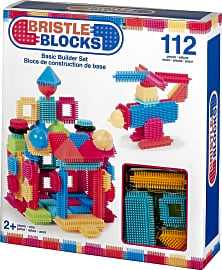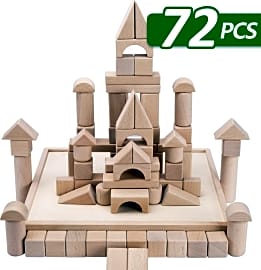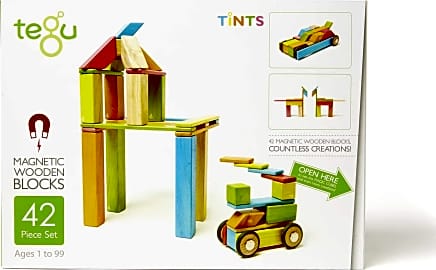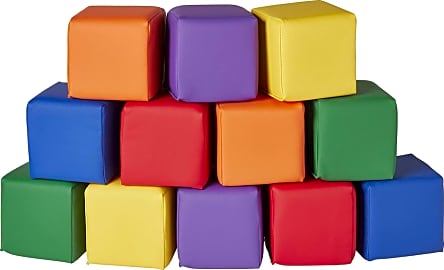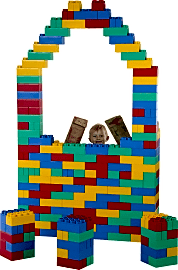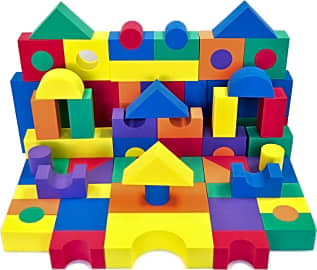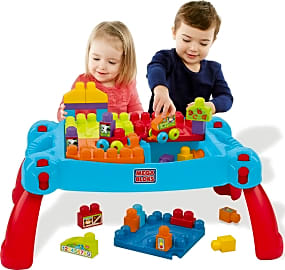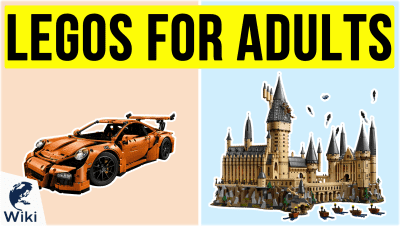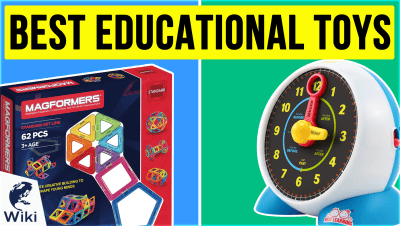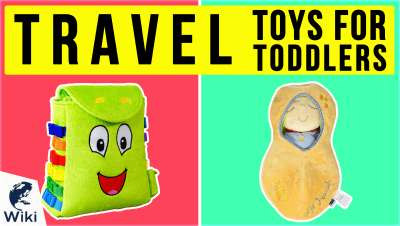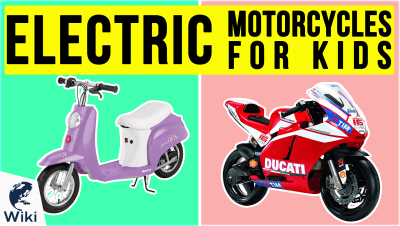The 10 Best Blocks For Toddlers

This wiki has been updated 37 times since it was first published in July of 2015. Building blocks for toddlers are popular toys for many reasons, not least of which is their ability to develop a child's spatial reasoning, motor skills, and dexterity, while teaching them about spelling, numbers, and colors. While we've provided a fun selection of options, remember that the unexpected can happen when little ones are at play, so make sure they have the proper adult supervision. When users buy our independently chosen editorial selections, we may earn commissions to help fund the Wiki.
Editor's Notes
May 06, 2020:
Of all the games I can remember playing at this age, the toys from which I derived the most satisfaction were my block sets. I had all the classics, but what I liked the most about blocks was the ability to hold them in my hands, to feel their shapes, imagine how to put them together, and ultimately to construct something whole out of what was previously a jumbled mess. Blocks still provide people a sense of fun, even when they reach adulthood. But when it comes to learning, versatility is key with building block sets geared for toddlers. Knowing that your kid will eventually be going to school, there is no better way to encourage early STEM learning than with a set of building blocks. STEM is an acronym that defines a learning curriculum focused on the fundamental disciplines of science, technology, engineering and mathematics. For that reason, we've included a variety of sets that allow toddlers to begin following this curriculum without having to be in the classroom. Instead, they can use their imaginations to build things out of small pieces, allowing them to visualize and create objects that represent these disciplines, while simultaneously developing their fine and gross motor skills.
The Melissa & Doug Classic, for example, offers 100 pieces in bright primary colors and several shapes, teaching little ones how to recognize certain designs and to create familiar structures out of them.
For young kids who love to chew on things, the B. Toys One Two Squeeze is an excellent and safe option to consider. Not only are they soft, squishy, and noisy, but they also feature a series of animals and number patterns on them.
Although the Tegu Tints might have a steeper learning curve than some of our other options, their embedded magnets can train young minds to assemble three-dimensional objects and recognize the differences between positive and negative polarity.
Despite the additional cost of the Kids Adventure Jumbo, the idea of using extra-large blocks to construct something that is almost life size is just really cool, especially for a little kid. It can reinforce their sense of creativity and "shape" how they see the world around them.
We've also added the EWonder World Wonder Blocks as a good alternative to wooden sets, as their EVA foam construction remains gentle to the skin, while preventing damage to walls should your child choose to act out and throw his toys around. Their waterproof design and ability to float make them fun to play with in the bathtub or pool.
The Mega Bloks Build N Learn is a great option for travel, thanks to its folding design and on-board component storage.
While we've done our best to include options that are safe for all toddlers considered, that is no substitute for adult supervision. You should always keep an eye on your children when they play, especially when they use our wooden block sets. In this case, however, you don't have to think of supervision as a chore, since many of our options make it easy for you to jump in and spend quality time helping your little one construct their next masterpiece.
Special Honors
ESpecial Needs Founded in 2002 in St. Louis, Missouri, ESpecial Needs is dedicated to providing resources (e.g. therapeutic devices and toys) to children with special needs. The company's extensive product line includes assistive technology, art supplies, utensils, furniture, toys, and more. One of its products is a 35-piece giant play block set, the components of which measure 12 inches thick. especialneeds.com
Monti Kids Monti Kids is a subscription-based service that provides a learning curriculum in the Montessori format, which seeks to develop a child's natural interests using variety of toys and activities rather than formal education. The service offers eight levels of engagement that span from ages 0-3, beginning with the development of basic visual and motor skills all the way through spatial and math awareness. montikids.com
Building Your Child’s Future, One Block At A Time
Ultimately, what’s printed on the blocks may be secondary to another developmental benefit these toys can offer children.
Over the course of your child’s youth, you’ll want to expose them to as much experience and information as possible. The more they can see and learn from their earliest days, the better equipped they’ll be to face the challenges of school, the workforce, relationships, and even their creative endeavors.
The great thing about the human brain is that it learns even when its owner doesn’t know it’s learning. How often have you cited some piece of information you have stored somewhere in your brain, but you couldn’t — for the life of you — remember where you saw or heard it? Chances are you were staring out the window in science class, wondering whether the leaves were going to start changing colors, while your teacher explained the difference between a quasar and a pulsar. Yet, somehow, without even meaning to, you retained the information.
Traditionally, children’s block sets come with letters printed on them, even if the children for whom they’re intended won’t begin to read for another few years. This early exposure can build recognition in the brain, which will unconsciously record individual letter shapes, as well as pairings of letters, albeit with no sonic, phrasal, or meaningful correlations.
Of course, blocks today can come with anything printed on them, and you’ll see sets on the market depicting everything from numbers, colors, and the alphabet to the periodic table of elements. In some cases — as with the periodic table — you’ll come across a set that can maintain its usefulness long after your child has grown past the age considered appropriate to playing with blocks. If a 12-year-old uses block combinations to study elements and the formation of molecules, and that helps them pass a 6th grade science exam, then you got some serious mileage out of your investment.
Ultimately, what’s printed on the blocks may be secondary to another developmental benefit these toys can offer children. Toddler blocks are among the first items your child will use to develop important motor skills. It takes hand-eye coordination, patience and precision to build a block tower. Even more thoughtful planning must go into more elaborate structures like pyramids. These early experiments can lay the groundwork to turn your tot into the next Frank Lloyd Wright.
A very different career path than that of the architect may start here, as well. Once children have spent countless hours developing the most elaborate block cities their little minds could imagine, there’s one left for them to do that provides as much fun in just a few seconds as the entire building process gave them. What is it? Well, let’s just say that the military and construction crews are always in need of a good demolitions expert.
Choosing The Right Blocks For Your Tot
Block sets have come an awful long way over the years, and the models available on our list cover a great many shapes, sizes, and styles. Choosing the set that your kid is absolutely going to love has as much to do with their personality as it does your ambitions for them.
Choosing the set that your kid is absolutely going to love has as much to do with their personality as it does your ambitions for them.
A youngster who hasn’t yet exhibited a particular affinity toward any one style of play could potentially do well with any block set. That makes them a kind of blank canvas, if you will, on which you can pin some of your hopes for their future. If you want to encourage their metaphorical minds, the beginnings of which can be found in the first, unguided exposure to a correlation between language and perception, blocks with familiar sights and their corresponding names would be most welcome.
Your child may have already tipped their hand in a certain direction, though. Perhaps the old trick in which you move a magnet on the top of a table with another hidden beneath the table (by magic, you told them) fascinated them for hours. Then, a set that employs some form of magnetism to adhere the blocks to each other could be a great idea. Such a gift may set in motion an appreciation of the sciences that could last the child’s lifetime.
It also might be a good idea to reckon with your child’s level of violence. Young children, especially boys, can pick up surprisingly violent behaviors at a very early age. These children are not the best candidates for heavier blocks or any other block that could make itself into a handy weapon come play time. Fortunately, there are sets out there that are lightweight and harmless, even in the hands of your little sociopath.
A Brief History Of Children’s Blocks
Toys of any sort weren’t terribly common among children for the majority of human existence. Children might have had a doll or two, but they were largely left to their own devices until they were old enough to work, which was pretty young until child labor laws came along during the Industrial Revolution. Still, the upper classes in society always sought devices that could help teach their children, and blocks are an old favorite.
Toys of any sort weren’t terribly common among children for the majority of human existence.
The first documented reference to blocks designed for children’s educational play comes from the writings of the philosopher John Locke in the late 17th century. He hypothesized that such blocks, adorned with the letters of the alphabet, would be advantageous in teaching a child to read. The influence of this thought rings true even in today’s block designs.
The blocks were later mentioned in a book on educating children that came out more than a century later, and by 1820, inventor S.L. Hill began producing blocks for children out of his shop in Brooklyn.
The big push came in the late 1830s, however, when Friedrich Fröbel designed Fröbel’s Gifts, a set of toys intended to give children an edge in spacial and color relations. These early toys continue to inform the production of educational toys for children, even in the midst of our digital revolution.



